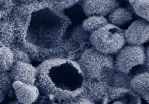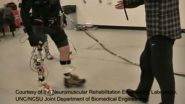A coating that protects against heat and oxidation
2014-11-21
(Press-News.org) Gases don't conduct heat as well as solids do. Cellular or aerated concretes take advantage of this effect, which experts call "gas-phase insulation". The heat barrier is achieved by air encased in the cavities of the concrete. But gas-phase insulation has far greater potential than keeping our homes warm. It can also be used to protect turbine engine and waste incinerator components when subjected to intense heat. All you need to do is transfer this effect to a coating that is just a few hundred micrometers thick.
Temperature differences of over 400 degrees Celsius
Scientists at the Fraunhofer Institute for Chemical Technology ICT in Pfinztal have not only done just that, they've also done it in a particularly economical way. They've designed a coating that consists of an outer topcoat from conjoined aluminium oxide spheres. "These spheres are hollow and filled with gas," explains coatings expert Dr. Vladislav Kolarik from the ICT's Energetic Systems department. When the outer side of a part is exposed to temperatures of 1000 degrees Celsius, these gas-filled spheres reduce temperatures on the part's inner side to under 600 degrees Celsius - as the ICT scientists have demonstrated in their laboratories. Since gas and steam turbines used for energy generation, combustion chambers, waste incinerator generators and temperature sensors, and reactors in the chemical and petrochemical industries are all subjected to temperatures of up to 1000 degrees Celsius, there is considerable demand of thermal protection.
What's most remarkable is that the heat insulating layer from hollow aluminium oxide spheres is obtained on the basis of a conventional, economic process. Operators only have to do some simple math to see the benefits: conventional thermal barrier techniques - most of which are based on ceramic materials - are expensive. The process the scientists adapted was originally designed to protect metallic components from oxidation. "We've optimized the technique so that the coat not only retains its oxidation protection, but furthermore protects against heat," says Dr. Kolarik. The basic coating layer forms by interaction of aluminum particles and the metallic component. This is done by depositing aluminum powder on the surface of the metal and heating it all up to a suitable temperature over several hours. The result is an aluminum-rich coating on the component's surface that protects against oxidation at high temperature. With the new procedure the topcoat from the hollow aluminum oxide spheres is additionally formed. "Up to now, it never occurred to anyone to use these spheres to produce another coating layer - they were just a waste product," says Dr. Kolarik.
Now the scientists have refined the process so they can produce both coating layers in the required thickness. The way it works is to take aluminum particles and mix them with a viscous liquid bonding agent. This produces a substance similar to a paint or slurry, which the scientists then manually paint, spray or brush onto the metallic component. "All that's left is to add a fair bit of heat," says Dr. Kolarik. But it's all easier said than done: Dr. Kolarik and his team have had to precisely fine tune the size and size distribution of the aluminum particles, the temperature and duration of the heating stage and the viscosity of bonding agents. "Just like a master chef, the first job was to come up with a winning recipe."
"We're currently in the process of putting the findings from the EU-funded PARTICOAT project into practice. This involves coating bigger and bigger components without exceeding the temperature limits for each application area. At the same time we're trying out techniques to automate the whole coating process. Our plan is to follow in the footsteps of the aerated concrete that helps insulate our homes - that's been in series production for a long time now," says Dr. Kolarik.
INFORMATION:
More information:
http://www.particoat.eu
[Attachments] See images for this press release:

ELSE PRESS RELEASES FROM THIS DATE:
2014-11-21
The fixed combination of canagliflozin with metformin (trade name: Vokanamet) has been approved since April 2014 for adults with type 2 diabetes mellitus in whom diet and exercise do not provide adequate glycaemic control. The German Institute for Quality and Efficiency in Health Care (IQWiG) now examined in a dossier assessment whether the new drug combination offers an added benefit over the appropriate comparator therapy. No such added benefit can be derived from the dossier, however, because the manufacturer did not present any suitable data for any of the possible ...
2014-11-21
Lugano/Geneva, Switzerland, 21 November 2014 - The possibilities for personalised vaccines in all types of cancer are revealed today in a lecture from Dr Harpreet Singh at the ESMO Symposium on Immuno-Oncology 2014 in Geneva, Switzerland.
"One of the biggest hurdles in cancer immunotherapy is the discovery of appropriate cancer targets that can be recognised by T-cells," said Singh, who is scientific coordinator of the EU-funded GAPVAC phase I trial which is testing personalised vaccines in glioblastoma, the most common and aggressive brain cancer. "In the GAPVAC trial ...
2014-11-21
Public health researchers from the University of Adelaide have evaluated international breast cancer guidelines, finding that there is potential to improve surveillance of breast cancer survivors from both a patient and health system perspective.
International guidelines recommend annual follow-up mammograms for every woman after treatment for early breast cancer, regardless of the risk of her cancer returning. There is also no strong evidence to support annual mammography compared with other possible mammography schedules.
In a paper published in the journal Value ...
2014-11-21
VIDEO:
Powered lower limb prosthetics hold promise for improving the mobility of amputees, but errors in the technology may also cause some users to stumble or fall. New research from the...
Click here for more information.
Powered lower limb prosthetics hold promise for improving the mobility of amputees, but errors in the technology may also cause some users to stumble or fall. New research examines exactly what happens when these technologies fail, with the goal of developing ...
2014-11-21
Bethesda, MD (Nov. 21, 2014) -- Cirrhosis and nonalcoholic fatty liver disease (NAFLD) are two serious liver conditions with limited pharmacological treatments. The December issues of AGA's journals -- Clinical Gastroenterology and Hepatology and Gastroenterology -- highlight important updates into treatments for these two debilitating diseases.
For access to any of these studies, or to speak with the study authors, please contact media@gastro.org or call 301-272-1603.
Promising Probiotic for Liver Disease
A study published in Gastroenterology1 found that, over a ...
2014-11-21
EAST LANSING, Mich. --- Don't get along with your boss? Your job performance may actually improve if the two of you can come to grips with the poor relationship.
A new study led by Michigan State University business scholars finds that workers are more motivated if they and their supervisors see eye-to-eye about a bad relationship than if they have different views about their relationship. The findings are published in the Academy of Management Journal.
"Seeing eye-to-eye about the employee-supervisor relationship is equally, if not more important than the actual quality ...
2014-11-21
SCOTTSVILLE, SOUTH AFRICA-- Worldwide, drought conditions, extreme temperatures, and high soil saline content all have negative effects on tomato crops. These natural processes reduce soil nutrient content and lifespan, result in reduced plant growth and yield, and ultimately translate to lower profits for tomato producers. As an alternative to unsustainable practices such as the use of synthetic fertilizers, producers are looking to environment-friendly soil ameliorants such as verimcompost leachate, an organic liquid produced from earthworm-digested material and casts ...
2014-11-21
TUSCON, AZ - Soil solarization, a process that uses solar radiation to rid the soil of pests, is most common in regions with high solar radiation and high temperatures during the summer season. An alternative to soil fumigation, the process is used either alone or in combination with fumigants. To accomplish solarization, solar radiation is used to passively heat moist soil covered with clear plastic sheeting, with the goal of increasing soil temperatures to the point where they are lethal to soilborne organisms. The effectiveness of solarization is based on the actual ...
2014-11-21
Quebec City, November 21, 2014--Scientists from Université Laval, the University of British Columbia and the University of Oxford have discovered a natural resistance gene against spruce budworm in the white spruce. The breakthrough, reported in The Plant Journal, paves the way to identifying and selecting naturally resistant trees to replant forests devastated by the destructive pest.
A research team composed of professors Éric Bauce, Joerg Bohlmann and John Mackay as well as their students and postdocs discovered the gene in spruces that had remained relatively ...
2014-11-21
Employees who work at small, locally owned businesses have the highest level of loyalty to their employers -- and for rural workers, size and ownership of their company figure even more into their commitment than job satisfaction does, according to Baylor University researchers.
Higher levels of commitment are associated with less absenteeism, lower turnover and less seeking of jobs outside the company. The study -- "Small, local and loyal: How firm attributes affect workers' organizational commitment" -- is published in the journal Local Economy.
"It's an interesting ...
LAST 30 PRESS RELEASES:
[Press-News.org] A coating that protects against heat and oxidation



